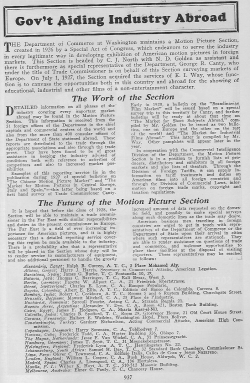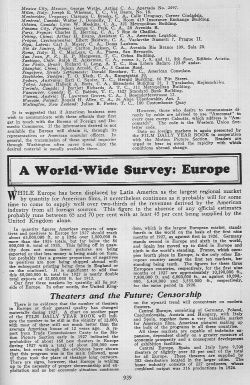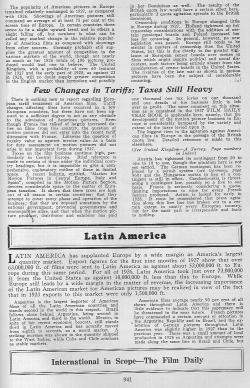Vintage: International Distribution In 1927, Part 1
A relatively new industry and a relatively new product means a relatively new export. In the 1920s, American studios were eager to sell their product in foreign markets, but it's not as simple as that. Do the foreign markets have the theaters to show films in? What are the import tariffs going to be? And to wrap us back to the promise given at the end of Episode 39, what are the censorship laws in these foreign markets that imported American films will be subject to?
Many of these foreign nations were interested in building up film industries of their own. Doing that is much more difficult when there are big budget imported American films competing for the box office dollar. Consequently, some foreign markets were friendlier to importing American films than others. The ones that weren't hampered the process with high tariffs and, in some cases, creating censorship boards that were strict on American films and more permissive on domestic films. Other censorship boards were more earnestly established to regulate content, and it is revealing sometimes what type of content they sought to regulate.
These same issues continue to be wrestled with today. Modern day China is still strict and stingy about what American films it allows to play within its borders, for reasons of both censorship and nurturing the local film industry. This has widespread ramifications, including with issues of piracy (piracy is huge in China, at least in part because of the scarcity of legal alternatives).



As I said earlier, it is sometimes revealing to see what type of content is of greatest concern to particular censorship boards. Today, it's oft-repeated that Europe is more concerned about violence, whereas America is more concerned about sex. That's probably true as a generality, but it's one of those things that's repeated so often and accepted without question that I question it. The reality is probably more nuanced.
But in 1927, neither violence nor sex is mentioned as the primary concern of European censorship boards. Europe was in a tenuous situation, politically, between the two World Wars. Germany was defeated at the close of World War I, but the political situation remained unstable and ultimately led to World War II. Europe was a bit on edge, and many people feared things that might aggravate the unease. The power of propaganda was well understood, of course, and suddenly here were movies, a relatively new entertainment medium, one uniquely suited to inspiring emotion, was taking over the world. Small wonder that many feared it. In 1925, Sergei Eisenstein made what remains one of the most powerful demonstrations of the ability of the movies to sell a political ideal and call to action: Battleship Potemkin, one of the greatest films of all time. I'm not saying that Battleship Potemkin was forefront in the minds of the European censorship boards of 1927, but it illustrates that film not only could be used as effective propaganda, it had.
The rest of page 3 is interesting, but for this commentary I'll skip ahead to page 4. The paragraphs at the top discuss "agitation against American films." A note is made there were "on occasions a certain level of dissatisfaction at times" over the portrayal of Latin Americans. (Note that "Latin America" seems to refer to a broader geographic area than we generally use the term for today.)
Issues of racism and racial stereotypes come up again more strongly in the next section on The Far East. In the 1920s, India, along with a number of other places, was still under the rule of the British Empire. Note the line about tightening censorship guidelines: "The idea was not that films in and of themselves are immoral or unfit for showing, but that films which can safely be shown to European audiences exercise a far different effect on primitive and subject races." You'd get raked over the coals for publishing a line like that today, which perhaps illustrates just how far we've come. But there it is; let's consider it.
Often the basis for racism is fear. Read between the lines. Did the British Empire fear the loss of its rule over India? Let's put this into historical context. In 1927, Gandhi had been a recognized name for ten years, and although India would not win its independence until 1947, it was well along the path that would ultimately lead there. It is not surprising that the British Empire would be nervous about importing influential media.
The last page covers "The Near East" (another interesting example of evolving terminology) and Africa. I have no particular comments about the text here, but it is interesting nonetheless.
Next week, we'll take a closer look at the censorship concerns of individual nations. These introductory pages treat continents more or less as a whole, but things get even more interesting and even a little quaint, once you start looking at the idiosyncrasies of individual countries.
|


